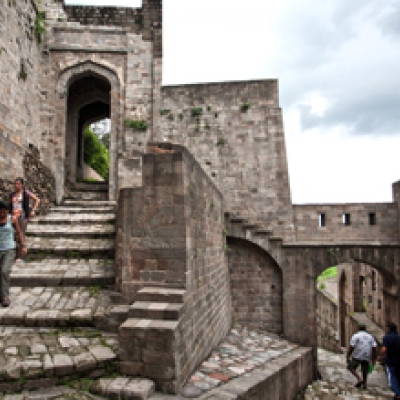
Kangra Fort
If you are a fan of exploring places steeped in art and history, then Kangra Fort is the perfect place for you. This majestic fortress located in the Himalayan foothills was once home to some of the bravest hearts. The fort is believed to have been built by the great king Susharma Chandra who belonged to the Trigarta Kingdom, located in the hills of North India near Kangra, and was a descendant of the Katoch family. This site is a delight for history buffs because legend says numerous packs of wealth belonging to the Rajput family are buried here, but despite extensive research, nothing has been found yet.
Kangra Fort - Himachal Pradesh - India
The place is most commonly identified as Nagarkot or Kot Kangra. In the phrase Katoch, "Kat" means army, "Uch" means upper class, and "Kot" means fort. Overall, the region is known as Kotch, which means those who lived within the fort, but later generations called it Katoch.
The grand entrance itself looked like a barricade while Kangra Fort was one of the largest and certainly the oldest forts in the state. This historical monument showcased the heritage and culture of the country’s ancient rulers. Located at the heart of the Himachal, the crown jewel of the district was proudly Kangra Fort. Senior among the Himalayas, the fort was under the purview of the Archaeological Survey of India, which highlighted the fort's significance in the nation. The confluence of the rivers Manjhi and Banganga was where the fort sat, which enhanced the beauty of the place as a major tourist attraction in Kangra.
The fort exchanged hands between Rajputs, Mughals, Gurkhas, and Sikhs over time. Finally, it settled under the control of the British government until the massive earthquake in 1905 caused severe damage to the structure. Following India's independence in 1947, the Government of India (GOI) assumed control of Kangra Fort, which has remained under government and ASI protection.
The inscription beside the gates stated they were installed during the Sikh's reign. Past the gates, a long, narrow passage took visitors to the hilltop fort, revealing the sweeping vista of the valley below. Crossing the giant Amiri Darwaza gate via stairs and the Ahani Darwaza second gate was an arduous climb but offered respite in the cool, crisp air. The castle’s breathtaking design astounded guests, making it challenging to comprehend its architectural patterns. Dazzling valley views from the fort top encouraged further exploration.
The soft pastel hues of the sun rising and setting could be cherished from the Jehangiri Darwaza gate. Finalizing the trip by visiting the sacred shrines of Lakshmi Narayan, Sitlamata, and Devi Ambika, temples complemented by Jains, was a must. The rare seated image of Lord Adinath dating back to 1523 AD adorned the heights. Visitors could doze off with the remnants of history in their hearts one last time.
Visiting Hours:
Opens from 9:00 a.m. to 5:30 p.m.
Entry fee:
With Audio Guide for Indians: Rs. 150 per person, and for foreigners: Rs. 300 per person. Audio guides are sold at the entrance.
Best time to visit:
September to June is the ideal time to explore the place. If you are not cold-resistant, try to avoid December to January, when the temperature falls below zero.
How to reach Kangara Fort ?
By Air : Gaggal Airport, Kangra, is the closest terminus.
By Rail : Pathankot railway station is the nearest railway station to Kangra.
By Road : Direct transportation is available to the place from major cities, and roads are well connected too.